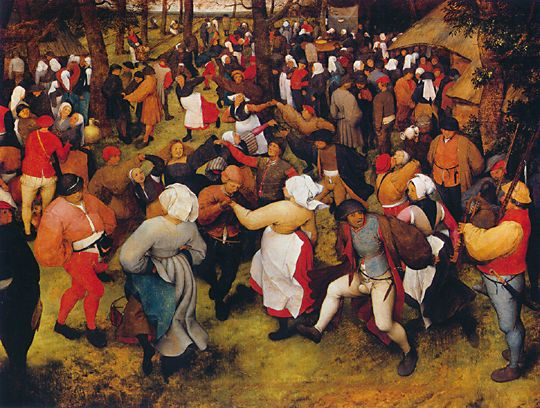The head of that female serpent is in Michelangelo's Sistine Chapel's Expulsion. What I also like is the use of color on that serpent: the irridenscent greens and yellows, with the cool colors in front of the warm colors (the reverse of what we'd expect). And they said, when the Sistine Chapel was being cleaned recently, that Michelangelo had no sense of color!

Also notice that Eden's side has some bare scrappings of landscape, while the other side is barren. Some of these ideas are from DVDs from the Teaching Company.org on Renaissance art, lectures by Dr. William Kloss. Fascinating.
I'm glad you appreciate what I do up for FR. Any break I can get from exams....
I made a big mistake and, when running out of time, neglected those three artists mentioned in the first paragraph: Durer, Brueghel, and Bosch. I was going to quiz Leni to see if she would catch what I missed, but I’m going to discuss those men anyway.



Durer was a Renaissance man of Germany. We can track his self-portraits and see what he thought of himself: even resembling Christ. He did some wonderful engravings as prints, as in Adam and Eve, so that everyone could be a collector of his works. Notice that he maintains the northern sense of detail, but his anatomy is now as good as that of Italy. Even in his Piece of Turf, he is so detailed that botanists today can identify dozens of different grasses.


Brueghel, although not a peasant himself, did wonderful works of peasants’ lives. His figures have a monumentality like that of Michelangelo, whose works he did see in Italy. They also have a sense of humor, as in the Peasant Wedding above. Notice the proud, but rather homely, bride in front of the green cloth. Notice the hungry bagpiper and the greedy child who has already taken a pie from the platter (really a door) that just went by. There is also great exuberance in his dances.


Bosch is impossible to characterize, unless it is as a forerunner of Surrealists like Dali. His Garden of Earthly Delights has a kind of Eden on the left, with God introducing Eve to a goggling Adam. But what are those strange pink and blue forms in the background? In the middle, there is an odd parade in the background and many weird figures in the foreground: men with giant strawberries between their legs or with arrows up their rear ends. There is a sense of sin and lechery, and yet the whiteness of the figures, and the lack of voluptuousness of the women, lends a kind of innocence to the work. Is this our daily world of sin and temptation? On the right, the tortures of hell: crucifixion on a harp, those swallowed by Satan are then excreted underneath. The funny man in the egg shell may be a self-portrait of Bosch, and the bagpipes may represent sexual desire. But the symbolism is far too complex to do justice to here. There are many images of this which you can find on any search engine under Bosch and/or Garden of Earthly Delights, but I didn't want to take up too much pixel room here.







